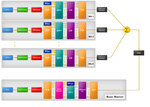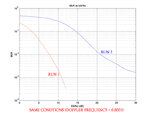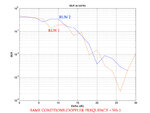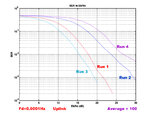ammaralwazzan
Newbie level 6

hi everybody
i have a bad problem with my code ....
First of all i write a matlab code for OFDM-CDMA system. the following picture shows the structure of the system :

but unfortunally the results for BER not stable .
for doppler frequency = 0.0001

for doppler frequency = 3Hz

notes:
1) i use the built in matlab function rayleighchan for implement the effect of Rayleigh channel.
2) i choose the uplink case (as the system structure showed)
3) i generate a OFDM-CDMA signal for each user then each signal enter alone [/COLOR]to rayleighchan then i add the all signals together then adding AWGN and finally enter to receiver.
4) i calculate the BER for user number one only
5) i make iteration for the code ,, and i reach to 500 times without reach to stable result
6) for checking i run the code without any channel (nor rayleigh nor AWGN) i get 0 errors.
7) i use an itu recommendation for parameter of rayleigh channel which is channel A for indoor to outdoor case
(you can type in matlab help for this channel simply it is 4 path channel with delay equal to (0 110 190 410)nSec and path gain equal to (0 -10 -20 -23) dB)
Any help will be appreciated
thank you to everyone read, comment or help in this problem
i have a bad problem with my code ....
First of all i write a matlab code for OFDM-CDMA system. the following picture shows the structure of the system :

but unfortunally the results for BER not stable .
for doppler frequency = 0.0001

for doppler frequency = 3Hz

notes:
1) i use the built in matlab function rayleighchan for implement the effect of Rayleigh channel.
2) i choose the uplink case (as the system structure showed)
3) i generate a OFDM-CDMA signal for each user then each signal enter alone [/COLOR]to rayleighchan then i add the all signals together then adding AWGN and finally enter to receiver.
4) i calculate the BER for user number one only
5) i make iteration for the code ,, and i reach to 500 times without reach to stable result
6) for checking i run the code without any channel (nor rayleigh nor AWGN) i get 0 errors.
7) i use an itu recommendation for parameter of rayleigh channel which is channel A for indoor to outdoor case
(you can type in matlab help for this channel simply it is 4 path channel with delay equal to (0 110 190 410)nSec and path gain equal to (0 -10 -20 -23) dB)
Any help will be appreciated
thank you to everyone read, comment or help in this problem




